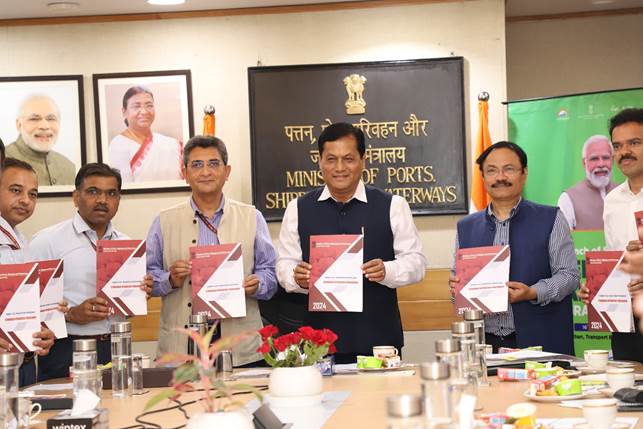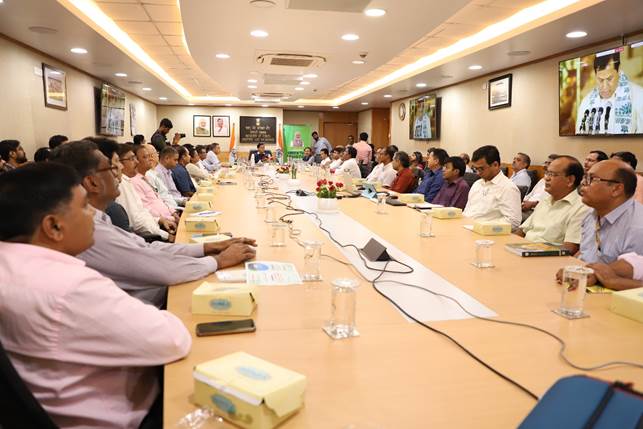
The Green Tug Transition Program is a pivotal initiative towards realizing our vision of a sustainable and green maritime sector in India : Sarbananda Sonowal
NEW DELHI : The Union Minister of Port Shipping and Waterways, Shri Sarbananda Sonowal officially launched the SOP for Green Tug Transition Program (GTTP) on Friday here. This landmark initiative is set to drive the transition from conventional fuel-based harbour tugs to greener, more sustainable alternatives, marking a major step in India’s commitment to environmental sustainability and the advancement of its maritime sector.
The Green Tug Transition Program (GTTP) as a key initiative under the ‘Panch Karma Sankalp’. The program, announced on May 22, 2023, by the Union Minister of Ports, Shipping, and Waterways, Shri Sarbananda Sonowal, during the ‘Chintan Shivir’ event, marks a significant step towards decarbonizing maritime operations in India. The GTTP is designed to phase out conventional fuel-based harbour tugs operating in Indian Major Ports and replace them with green tugs powered by cleaner and more sustainable alternate fuels.


Phase 1 of the GTTP will begin on October 1, 2024, and continue until December 31, 2027. During this phase, four Major Ports—Jawaharlal Nehru Port Authority, Deendayal Port Authority, Paradip Port Authority, and V.O. Chidambaranar Port Authority—will procure or charter at least two green tugs each, based on standardized designs and specifications issued by the Standing Specification Committee (SSC). The program is expected to involve an investment of around INR 1000 Crores in building these green tugs. The first set of tugs will be battery-electric, with provisions for adopting other emerging green technologies such as hybrid, methanol, and green hydrogen as the industry evolves.
Speaking on the launch, Shri Sarbananda Sonowal said, “The Green Tug Transition Program is a pivotal initiative towards realizing our vision of a sustainable and green maritime sector in India. This program not only aligns with our environmental goals but also strengthens our commitment to ‘Make in India,’ promoting domestic innovation and manufacturing in the maritime industry.”
The GTTP will be a major boost to the domestic tug industry, with all tugs built under this program constructed in Indian shipyards as part of the Government of India’s ‘Make in India’ initiative. The program is also expected to create significant employment opportunities in shipbuilding and ship design, mentioned Shri TK Ramachandran, Secretary, MoPSW.
By the end of 2040, all tugs operating in Indian Major Ports are envisioned to transition to green tugs, ensuring a standardized, eco-friendly fleet across the country. Furthermore, beyond 2033, any new tug built in India for use in Indian ports will need to comply with the ASTDS-GTTP standards.
The Maritime India Vision 2030 (MIV 2030), launched by the Prime Minister Shri Narendra Modi in 2020, outlines key strategies to enhance India’s maritime sector, aiming to make it a global leader in safety, sustainability, and environmental responsibility. This vision includes ambitious targets such as sourcing 60% of each major port’s power demand from renewable energy and achieving a 30% reduction in carbon emissions per ton of cargo by 2030. Building on this, the Maritime Amrit Kaal Vision 2047, introduced in 2023, sets a specific goal for Major Ports to reduce greenhouse gas emissions from port vessels by 30% by 2030. Harbor tugs, vital for port operations like berthing, unberthing, and ship assist functions, are ideal candidates for adopting green technologies, such as electric propulsion and alternative fuels, which can significantly cut emissions while maintaining operational efficiency.
The GTTP reflects the Government’s broader commitment to sustainability and innovation in the maritime sector, paving the way for a cleaner, greener future for India’s ports and maritime operations.
